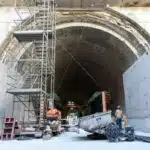Stair building is a technical process that requires skill and precision. Whether you are building stairs for a new construction or renovating an existing one, the task requires careful planning and execution to ensure safety and functionality. Stairs play an essential role in providing access between different levels of a building, and their design must adhere to specific regulations and standards.
To build stairs, one must first understand the principles of stair design. The process involves calculating the rise and run of each step, determining the number of steps required to reach a particular height, and accounting for factors such as headroom clearance and tread depth. Additionally, builders must consider the type of materials to use, whether it be wood, metal or concrete – each with its own strengths and weaknesses. This article will provide guidance on how to build stairs that are safe, functional, and aesthetically pleasing while adhering to necessary guidelines.
Understanding Stair Design Principles
Staircase ergonomics and step height consistency are critical principles in designing stairs that are both safe and comfortable to use. The vertical distance between each step, known as the rise, should be uniform throughout the entire staircase. This ensures that users can comfortably ascend or descend the stairs without having to adjust their gait or stride length. In addition, the horizontal distance between each step, known as the run, should also be consistent to provide adequate foot support.
To achieve optimal ergonomics in stair design, it is essential to take into account factors such as age, physical abilities, and intended use of the staircase. For instance, a staircase designed for elderly individuals or people with mobility issues may require a shorter rise and longer run to minimize strain on joints and reduce the risk of falls. On the other hand, a staircase intended for athletes or individuals with high levels of fitness may have steeper rises and shorter runs to create more challenging steps.
In summary, understanding stair design principles is crucial for creating safe and comfortable stairs. Proper attention must be paid to ensure that each step’s rise and run are consistent throughout the entire staircase while also considering factors such as intended use and user demographics. By optimizing these design elements, you can create a staircase that serves its purpose while minimizing potential safety hazards. Moving forward into calculating the rise and run of each step will ensure proper measurements needed for constructing a well-designed set of stairs.
Calculating The Rise And Run Of Each Step
Understanding the principles of stair design is crucial in building a safe and functional staircase. The rise and run of each step are important factors that determine the overall height and length of the stairs. But before we dive into calculating these measurements, it’s essential to have the right measuring tools on hand. These include a tape measure, level, square, and angle finder.
When measuring for step height, it’s important to consider both comfort and safety. The ideal rise height is between 6-8 inches, with a maximum of 9 inches. Going beyond this range can make it difficult for people to climb comfortably and increase the risk of tripping or falling. To ensure consistency in your measurements, use a level to check that the floor-to-floor height remains constant throughout.
To calculate the number of steps required for your staircase, you need to divide the total floor-to-floor height by the desired rise height per step. This will give you an approximate count of how many steps you’ll need in your stairway. However, remember that this calculation does not account for any landings or platforms that may be necessary. It’s always better to err on the side of caution and add an extra step if needed.
Determining the number of steps required is just one part of building a staircase, but it’s an essential step towards creating a safe and functional design. With careful attention to detail and precise measurements using appropriate tools, you can create stairs that are comfortable to climb and aesthetically pleasing while serving their practical function with ease.
Determining The Number Of Steps Required
Measuring techniques are crucial in determining the number of steps required when building stairs. The first step is to measure the total rise, which is the vertical distance between the floor level where the bottom of the stairs will be located and the floor level where the top of the stairs will end. This measurement should be taken as accurately as possible to ensure that there will be no issues with headroom clearance or safety.
Next, divide the total rise by a consistent measurement for each step’s height, usually around seven inches. This calculation will give you an estimate of how many steps you need to build your stairs. It’s essential to note that safety factors must be considered when deciding on your stair’s height and depth. A taller riser may require a shorter tread depth to maintain stability, while a shallower riser might increase the number of steps necessary.
In conclusion, measuring techniques and safety factors are critical when determining how many steps are required for building stairs. To ensure that your staircase meets safety standards, it’s essential to consult local building codes and regulations before beginning construction. In the next section, we’ll discuss accounting for headroom clearance when designing your staircase.
Accounting For Headroom Clearance
- Calculating headroom requires measuring the space between the surface of the stair to the ceiling and following the building regulations for the minimum headroom clearance.
- Ensuring safe clearance is critical to the design of the staircase, as the required headroom must be taken into consideration when designing the stair treads and risers.
- The headroom measurements should be taken before the stair is built, as the headroom clearance should be planned and accounted for during the stair design process.
- It is important to ensure that the headroom clearance meets the building regulations and is comfortable for the user.
- Designing for headroom should be done by elevating the stair above the floor to allow for a comfortable headroom clearance.
- The rise and run of the stair should also be taken into consideration, as it will affect the headroom clearance.
Calculating Headroom
Calculating headroom is an essential aspect of building stairs. It involves determining the minimum requirements for vertical clearance above treads and landings. This measurement is crucial because it ensures that people can move safely and comfortably up and down the stairs. The International Residential Code (IRC) specifies a minimum headroom of 6 feet 8 inches measured vertically from the tread nosing to the ceiling or any obstruction above. However, local codes may have additional requirements that builders must consider.
To calculate headroom, you need to measure the distance between the tread nose and any obstruction above, such as ceiling joists or light fixtures. If there is not enough space to meet the minimum requirement, creative solutions may be necessary, such as modifying ceiling height or adjusting stair design. For example, if installing a staircase in a basement with low ceilings, one could consider using alternating tread stairs or spiral stairs to conserve space while still providing adequate headroom.
In conclusion, calculating headroom is an essential step in building safe and comfortable stairs. Builders must ensure that they adhere to minimum requirements set by local codes and regulations while also being creative in finding solutions when faced with limited space or other obstacles. By following these guidelines, homeowners can enjoy stairs that are functional and aesthetically pleasing while also meeting safety standards.
Ensuring Safe Clearance
After calculating the headroom clearance, it is also crucial to ensure safe clearance for stair users. One way to achieve this is by installing handrails on both sides of the staircase. Handrails provide support and stability while climbing up or down the stairs, which reduces the risk of falls. The height of handrails should be between 34 to 38 inches from the tread nosing, and they should extend at least one foot beyond the top and bottom risers.
Another factor that contributes to safe clearance is proper lighting placement. Adequate lighting helps people navigate the stairs safely by providing clear visibility of each step. It also helps people identify any potential hazards or obstacles on their path. Builders should consider placing light fixtures at strategic locations along the staircase, such as above each landing or in dark corners.
In summary, ensuring safe clearance is vital for building a functional and secure staircase. Installing handrails and proper lighting placement are just a few ways to achieve this goal. By incorporating these elements into stair design, builders can create an environment where homeowners can move safely and comfortably throughout their home.
Designing For Headroom
Designing for headroom is a crucial aspect of stair building that should not be overlooked. Headroom clearance refers to the vertical distance between the highest point on a step and the ceiling or any other obstruction above it. This clearance is essential in ensuring that people can move comfortably up and down the stairs without hitting their heads on the ceiling. Proper headroom clearance is especially important in areas where people may need to carry bulky items or furniture up and down the stairs.
To design for headroom, builders must take into consideration the ceiling height in which the staircase will be installed. The minimum headroom clearance required by most building codes is seven feet, six inches from the top of each tread nosing to any overhead obstruction. However, this clearance may vary depending on local building codes and the intended use of the space. Builders should also consider adding at least two inches of additional headroom to accommodate tall individuals or those carrying large objects.
Designing for headroom requires careful planning and attention to detail. A lack of proper headroom clearance can result in discomfort, inconvenience, and even injury for users of the staircase. By incorporating adequate headroom clearance into stair design, builders can ensure that homeowners can move safely and comfortably throughout their home while avoiding any potential hazards or obstacles along their path.
Considering Tread Depth
After considering the importance of headroom clearance, let’s move on to another crucial aspect of stair building: tread depth. Tread depth refers to the horizontal distance between the front edge (nosing) of one step and the vertical riser of the next step. Properly calculated tread depth is essential for maximizing safety and enhancing comfort when using stairs.
Maximizing safety involves ensuring that each step provides enough surface area for safe footing. The International Residential Code (IRC) sets a minimum tread depth of 10 inches, but it’s important to note that this is just a starting point. Depending on your specific needs and preferences, you may choose to increase the tread depth for added safety and comfort. On the other hand, decreasing the tread depth can make stairs more compact and save space in tight areas.
Enhancing comfort involves finding a balance between sufficient surface area for safe footing and ease of use. If treads are too shallow, they can be uncomfortable or even dangerous to use. Conversely, treads that are too deep can be cumbersome and difficult to ascend or descend comfortably. When determining ideal tread depth, consider factors such as foot size, stride length, and overall user mobility.
Moving forward with stair building requires choosing the right materials for your project. From natural wood to composite materials, there are many options available that offer varying degrees of durability, aesthetic appeal, and affordability. By carefully selecting materials that meet your specific needs and budget while also prioritizing safety and comfort considerations discussed earlier, you can successfully build stairs that will serve you well for years to come.
Choosing The Right Materials
When it comes to building stairs, choosing the right materials is crucial. The materials used will affect the durability, safety, and overall aesthetics of the staircase. Cost-effective materials include concrete and steel, while sustainable options include bamboo and reclaimed wood.
Concrete stairs are a popular choice due to their durability and strength. They can withstand heavy traffic and extreme weather conditions without showing signs of wear and tear. Steel is also a great option for those looking for a long-lasting staircase. It is resistant to fire, mildew, and pests.
For those who prioritize sustainability in their building projects, there are plenty of options available. Bamboo is a cost-effective choice that grows quickly and is easy to maintain. Reclaimed wood is another eco-friendly option that utilizes salvaged wood from old buildings or furniture pieces.
By carefully considering the materials used in stair construction, builders can create a durable and sustainable staircase that meets both practical and aesthetic needs. In the next section, we will discuss the benefits of wood stair construction and how it compares to other material choices.
Wood Stair Construction
Accurately measuring the area where the stairs are to be built is essential to ensure that the stairs are properly sized and that the right materials are purchased. Appropriate materials should be chosen based on the design of the stairs, the weight the stairs must support, and the environment in which the stairs will be used. Any lumber used should be chosen for its strength and stability, as well as for its ability to withstand the elements. The type of hardware selected should also be chosen for its strength and durability, as well as ability to withstand the environment in which the stairs will be used.
Measuring For Stairs
Measuring for stairs is an essential step in the wood stair construction process. It requires careful attention to detail and precision to ensure that the staircase dimensions are accurate and safe for use. To begin measuring for stairs, you must first determine the total rise of the staircase. This measurement represents the vertical distance from the finished floor level to the top of the upper floor level.
Once you have determined the total rise, you can then calculate the number of treads needed for your staircase dimensions. A tread is defined as the horizontal surface of a step on which you place your foot when climbing up or down a flight of stairs. The ideal tread depth should be between 9 and 11 inches, while the riser height should be no more than 7 ¾ inches. When measuring for stairs, it’s important to keep in mind that each step must be identical in size to maintain balance and safety.
To accurately measure for stairs, use a tape measure or laser level to take precise measurements of each step’s width and length. You can also use a framing square to ensure that all angles are perfectly squared off at 90 degrees. Measuring techniques such as these will help ensure that your staircase dimensions are correct, allowing for easy installation and long-lasting durability. By taking extra care during this crucial stage of stair building, you can rest assured that your finished product will meet safety standards and provide years of reliable use for those who rely on it.
Choosing Materials
In addition to measuring for stairs, choosing the right materials is another crucial step in wood stair construction. While there are various materials available in the market, selecting the best one that suits your budget and needs can be challenging. Cost-effective options such as pine or poplar woods are commonly used for building stairs due to their affordability and durability. However, these materials may not be eco-friendly and may require more maintenance than other alternatives.
For those seeking eco-friendly materials for their wood stair construction project, bamboo is a great option. Bamboo is renewable, sustainable, and grows faster than most hardwoods, making it an excellent alternative to traditional woods. Another option is reclaimed wood, which is a popular choice for those who want a unique look while also being environmentally conscious. Reclaimed wood comes from old buildings or structures and can add character and history to your staircase design.
When choosing materials for your wood stair construction project, consider your budget, durability requirements, and environmental impact. Weighing these factors will help you make an informed decision when selecting the right material for your staircase. By carefully considering all options available to you, you can achieve a beautiful staircase that meets both your personal style preferences and functional needs.
Metal Stair Construction
Metal stairs are a popular choice for both commercial and residential construction due to their strength, durability, and aesthetic appeal. The fabrication of metal stairs involves several steps, including design, material selection, and welding techniques.
The first step in metal stair construction is to determine the design specifications. This includes determining the height and width of each step as well as the angle of inclination. Once the design is determined, the appropriate materials must be selected. Common materials used in metal stair fabrication include steel, aluminum, and stainless steel.
Welding techniques play a crucial role in metal stair construction. Proper welding ensures that the stairs are structurally sound and secure. Some common welding techniques used in metal staircase fabrication include MIG (Metal Inert Gas) welding and TIG (Tungsten Inert Gas) welding. These processes require skilled welders who can ensure that each weld is strong enough to withstand daily use.
Concrete Stair Construction
Metal stair construction offers a durable and modern option for building stairs, but for those seeking a more traditional look, concrete stair construction may be the way to go. Concrete stairs can be customized to fit any style and provide a solid foundation for years to come.
Pouring concrete is the first step in building concrete stairs. The area where the stairs will be placed must be cleared of any debris and leveled. Wooden forms are then set up to create the shape of the stairs. Reinforcing steel bars are placed within the forms to add support and stability to the structure.
Once the reinforcing steel bars have been placed, it is time to pour in the concrete mixture. The mixture should be poured slowly and evenly into each form until it fills up completely. After allowing time for the concrete to cure, the wooden forms can be removed, leaving behind a solid set of stairs ready for finishing touches.
- Building concrete stairs involves pouring concrete into wooden forms.
- Reinforcing steel bars are essential in creating sturdy stairs that can withstand weight.
- Once cured, wooden forms are removed leaving behind strong and durable stairs.
Building stairs for new constructions requires careful planning and attention to detail. From selecting materials to ensuring proper measurements, each step plays an important role in creating a safe and functional staircase. Whether metal or concrete construction is chosen, taking these steps will ensure that your new staircase is built with quality craftsmanship that will last for years to come.
Transition: Now that we have explored how to build concrete stairs, let’s move on to discussing key considerations when building stairs for new constructions.
Building Stairs For New Constructions
Staircase design is an essential aspect of building stairs for new constructions. The design process involves considering the number of steps, the height of each step, and the width of each tread. The rise and run measurements must be consistent throughout the staircase to ensure safety and ease of use. A well-designed staircase not only adds aesthetic value to a building but also provides a functional means of movement between different levels.
Construction techniques for building stairs involve several steps, including determining the location, measuring and cutting stringers, attaching treads and risers, and installing handrails. Stringers are the backbone of a staircase, supporting the weight of treads and risers. They must be accurately measured and cut to ensure that they fit snugly against the wall or support structure. Treads provide a flat walking surface on each step while risers form the vertical face between two treads.
Building stairs for new constructions requires careful planning and execution to achieve a safe and aesthetically pleasing result. By following established construction techniques and paying attention to staircase design principles, builders can create functional staircases that enhance a building’s overall appeal. In the next section, we will discuss renovation techniques for existing staircases, including repair options for damaged treads or risers.
Renovating Existing Stairs
After building stairs for new constructions, it’s important to know how to renovate existing stairs. Just like with new constructions, there are many factors to consider when renovating a staircase. However, this process comes with its unique challenges that require careful consideration.
Firstly, it’s essential to note that the lighting of the staircase is crucial. The right lighting can make all the difference and create a warm and inviting ambiance in your home. Staircase lighting options range from simple wall-mounted lights to intricate chandeliers. Additionally, you can install motion sensor lights that turn on automatically as you climb up or down the stairs.
Secondly, handrails are an integral part of any staircase. They offer support and safety while using the stairs and can also add aesthetic value to your home. There are various handrail options available today, including wooden handrails, wrought iron handrails, and glass handrails. When choosing a handrail option for your renovated staircase, consider both practicality and style.
Lastly, safety considerations should always be a top priority when renovating an existing staircase. Ensure that all steps are level and secure; treads should not be slippery or worn out. Additionally, ensure that there are no loose railings or protruding nails that could cause injury.
With careful consideration of these factors and professional guidance from experienced stair builders, you can successfully renovate your old staircase into a beautiful work of art while ensuring safety for all users.
Safety Considerations
When building stairs, safety should always be a top priority. The installation process must adhere to strict safety guidelines to prevent accidents and injuries. One crucial aspect of stair safety is the proper use of materials. Contractors must choose high-quality materials that are durable and sturdy enough to support the weight of individuals going up and down the stairs.
Another important consideration for safety when building stairs is the maintenance requirements. Regular inspections are necessary to ensure that everything is in good working order, including handrails, treads, and risers. Any signs of wear or damage should be addressed immediately to prevent any potential accidents.
Overall, ensuring safety during the installation process and maintaining stairs properly can go a long way in preventing accidents and injuries. Taking these measures seriously will not only protect those who use the stairs but also promote long-term functionality and accessibility.
Functionality And Accessibility
As important as safety is in building stairs, the functionality and accessibility of the stairs are equally crucial. One way to address both these aspects is by incorporating universal design principles. This type of design ensures that people of all ages, abilities, and sizes can use the stairs comfortably and safely.
When it comes to handrails for your stairs, there are a variety of options to consider. The most common choice is a wall-mounted handrail, which provides solid support for users. However, if there is no wall available or if you prefer a more decorative option, you can choose from a range of post-mounted handrails. These types of handrails are especially useful for outdoor stairs and are available in various materials like wood, metal, and vinyl.
In summary, when building stairs, it’s essential to think beyond just safety considerations. Incorporating universal design principles ensures that everyone can use the stairs with ease. Additionally, choosing suitable handrail options enhances accessibility while also adding an aesthetic appeal to your stairway. In the next section about aesthetics and design, we’ll explore different ways to create beautiful stairways that complement your home’s interior or exterior decor seamlessly.
Aesthetics And Design
When constructing a staircase, the aesthetics of the design should be taken into consideration. This includes selecting a color scheme, architectural style, and materials that are in proportion to one another and the space. Lighting, geometry, landscaping, artwork, and curb appeal should also be considered. Moreover, accessibility, outdoor living, finishes, finishing touches, space optimization, and Feng Shui should all be taken into account in order to construct a staircase that is both aesthetically pleasing and functional.
Color Schemes
When designing the aesthetics of a staircase, color schemes play a crucial role in creating an inviting and cohesive look. Color psychology can help determine which colors to use for the stairs. For example, warm colors like red and orange can evoke feelings of energy and excitement, while cool colors like blue and green can create a calming atmosphere. Understanding color psychology is essential in choosing the right color scheme for your stairs.
Popular color combinations for staircases are often based on complementary or analogous color schemes. Complementary colors are opposite each other on the color wheel, such as blue and orange or purple and yellow. Analogous colors are adjacent to each other, such as blue-green and green-yellow. These combinations create a harmonious look that is pleasing to the eye. Using these popular color combinations can help ensure that your staircase design appeals to a wide range of people.
When choosing a color scheme for your stairs, it’s important to consider the overall design aesthetic of your home or building. The colors should complement the surrounding décor and architecture while still standing out as an integral part of the design. By understanding color psychology and popular color combinations, you can create an aesthetically pleasing set of stairs that adds value to any space without overwhelming it with too many different hues.
Architectural Styles
The aesthetics and design of a staircase are crucial factors to consider when building a structure. One aspect that is often overlooked is the architectural style of the building. The architectural style greatly affects the overall look and feel of the staircase, so it’s important to choose a design that complements the structure.
For example, Art Deco architecture is known for its sleek lines and geometric shapes. A staircase designed in this style would feature clean lines, sharp angles, and bold contrasting colors. On the other hand, Gothic Revival architecture is characterized by intricate details and ornate designs. A staircase designed in this style would feature intricate carvings, elaborate railings, and dark wood finishes.
When designing a staircase in an architectural style, it’s important to pay attention to every detail to ensure that it fits seamlessly into the overall design aesthetic. The materials used should be consistent with the rest of the building’s finishes. Additionally, any decorative elements on the stairs should be in keeping with the architectural style.
In conclusion, incorporating an architectural style into staircase design can elevate the overall aesthetic of a building. By understanding how different styles influence design choices such as color schemes and materials, one can create a cohesive look that enhances both form and function.
Ensuring Adherence To Guidelines And Standards
Guidelines compliance is an essential aspect of building stairs. To ensure the safety and usability of the stairs, it is crucial to adhere to the guidelines laid out by local building codes and regulations. These guidelines provide specific requirements for the materials, dimensions, and design elements of stairs.
Inspection procedures also play a critical role in ensuring that the stairs meet guidelines and standards. Before completing construction on the stairs, thorough inspections should be conducted to identify any potential issues or areas of noncompliance. These inspections should be carried out by a qualified inspector who is familiar with local building codes and regulations.
Following these guidelines and inspection procedures will help ensure that the stairs are safe, functional, and aesthetically pleasing. By taking the time to comply with these standards, builders can create staircases that not only meet regulatory requirements but also exceed expectations in terms of quality and craftsmanship. Ultimately, this commitment to excellence will result in satisfied customers who can enjoy their new stairs with peace of mind.
Conclusion
Stair building is a technical process that requires precise measurements and adherence to guidelines and standards. Understanding the principles of stair design is crucial in ensuring safety, functionality, and accessibility. The rise and run of each step, the number of steps required, headroom clearance, tread depth, and safety considerations are all important factors to consider when building stairs.
In addition to these technical considerations, aesthetics and design play a significant role in creating stairs that are visually appealing. Staircases can be designed in various styles and materials to suit any architectural style or personal taste. As such, it is essential to strike a balance between form and function when building stairs.
To sum up, constructing stairs requires careful planning and attention to detail. Technical precision must be combined with creative flair to create stairs that are both safe and visually appealing. As the famous proverb goes: “Measure twice, cut once,” emphasizing the importance of taking the time to plan carefully before embarking on any construction project.
Image Credits
- “stairs” by tamaki (featured)









![How To Build A Detached Deck 9 Force Reconnaissance Detachment Deck Shoot [Image 4 of 4]](https://green-life.blog/wp-content/uploads/2023/05/RJo3tlizSGjq-150x150.jpg.webp)



















